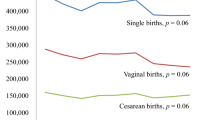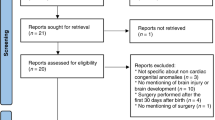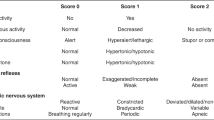Abstract
Objective:
The objectives of this study were to (1) establish the proportion of cerebral palsy (CP) that occurs with a history suggestive of birth asphyxia in children born at 32 to 35 weeks and (2) evaluate their characteristics in comparison with children with CP born at ⩾36 weeks with such a history.
Study Design:
Using the Canadian CP Registry, children born at 32 to 35 weeks of gestation with CP with a history suggestive of birth asphyxia were compared with corresponding ⩾36 weeks of gestation children.
Results:
Of the 163 children with CP born at 32 to 35 weeks and 738 born at ⩾36 weeks, 26 (16%) and 105 (14%) had a history suggestive of birth asphyxia, respectively. The children born at 32 to 35 weeks had more frequent abruptio placenta (35% vs 12%; odds ratio (OR) 4.1, 95% confidence interval (CI) 1.5 to 11.2), less frequent neonatal seizures (35% vs 72%; OR 0.20, 95% CI 0.08 to 0.52), more frequent white matter injury (47% vs 17%; OR 4.3, 95% CI 1.3 to 14.0), more frequent intraventricular hemorrhage (IVH) (40% vs 6%; OR 11.2, 95% CI 3.4 to 37.4) and more frequent spastic diplegia (24% vs 8%; OR 1.8, 95% CI 1.2 to 12.2) than the corresponding ⩾36 weeks of gestation children.
Conclusions:
Approximately 1 in 7 children with CP born at 32 to 35 weeks had a history suggestive of birth asphyxia. They had different magnetic resonance imaging patterns of injury from those born at ⩾36 weeks and a higher frequency of IVH. Importantly, when considering hypothermia in preterm neonates with suspected birth asphyxia, prospective surveillance for IVH will be essential.
This is a preview of subscription content, access via your institution
Access options
Subscribe to this journal
Receive 12 print issues and online access
$259.00 per year
only $21.58 per issue
Buy this article
- Purchase on Springer Link
- Instant access to full article PDF
Prices may be subject to local taxes which are calculated during checkout



Similar content being viewed by others
References
Jacobs SE, Berg M, Hunt R, Tarnow-Mordi WO, Inder TE, Davis PG . Cooling for newborns with hypoxic ischaemic encephalopathy. Cochrane Database Syst Rev 2013; 1: CD003311.
Garfinkle J, Wintermark P, Shevell MI, Platt RW, Oskoui M . Cerebral palsy after neonatal encephalopathy: how much is preventable? J Pediatr 2015; 167 (1): 58–63 e51.
Chalak LF, Rollins N, Morriss MC, Brion LP, Heyne R, Sanchez PJ . Perinatal acidosis and hypoxic-ischemic encephalopathy in preterm infants of 33 to 35 weeks' gestation. J Pediatr 2012; 160 (3): 388–394.
Hirvonen M, Ojala R, Korhonen P, Haataja P, Eriksson K, Gissler M et al. Cerebral palsy among children born moderately and late preterm. Pediatrics 2014; 134 (6): e1584–e1593.
Laptook AR . Neurologic and metabolic issues in moderately preterm, late preterm, and early term infants. Clin Perinatol 2013; 40 (4): 723–738.
Gunn AJ, Bennet L . Brain cooling for preterm infants. Clin Perinatol 2008; 35 (4): 735–748 vi-vii.
Higgins RD, Raju T, Edwards AD, Azzopardi DV, Bose CL, Clark RH et al. Hypothermia and other treatment options for neonatal encephalopathy: an executive summary of the Eunice Kennedy Shriver NICHD workshop. J Pediatr 2011; 159 (5): 851–858 e851.
Haynes RL, Sleeper LA, Volpe JJ, Kinney HC . Neuropathologic studies of the encephalopathy of prematurity in the late preterm infant. Clin Perinatol 2013; 40 (4): 707–722.
Back SA, Luo NL, Borenstein NS, Levine JM, Volpe JJ, Kinney HC . Late oligodendrocyte progenitors coincide with the developmental window of vulnerability for human perinatal white matter injury. J Neurosci 2001; 21 (4): 1302–1312.
Volpe JJ . Brain injury in premature infants: a complex amalgam of destructive and developmental disturbances. Lancet Neurol 2009; 8 (1): 110–124.
Heibel M, Heber R, Bechinger D, Kornhuber HH . Early diagnosis of perinatal cerebral lesions in apparently normal full-term newborns by ultrasound of the brain. Neuroradiology 1993; 35 (2): 85–91.
Volpe JJ Intracranial hemorrhage. Fletcher J (ed). In: Neurology of the Newborn. Elsevier Health Sciences: Philadelphia, 2008, pp 483–588.
Teune MJ, Bakhuizen S, Gyamfi Bannerman C, Opmeer BC, van Kaam AH, van Wassenaer AG et al. A systematic review of severe morbidity in infants born late preterm. Am J Obstet Gynecol 2011; 205 (4): e371–e379.
Garfinkle J, Wintermark P, Shevell MI, Oskoui M . Cerebral palsy after neonatal encephalopathy: do neonates with suspected asphyxia have worse outcomes? Dev Med Child Neurol 2016; 58 (2): 189–194.
Rosenbaum P, Paneth N, Leviton A, Goldstein M, Bax M, Damiano D et al. A report: the definition and classification of cerebral palsy April 2006. Dev Med Child Neurol Suppl 2007; 109: 8–14.
Oskoui M, Coutinho F, Dykeman J, Jette N, Pringsheim T . An update on the prevalence of cerebral palsy: a systematic review and meta-analysis. Dev Med Child Neurol 2013; 55 (6): 509–519.
Shankaran S, Laptook AR, Ehrenkranz RA, Tyson JE, McDonald SA, Donovan EF et al. Whole-body hypothermia for neonates with hypoxic-ischemic encephalopathy. N Engl J Med 2005; 353 (15): 1574–1584.
Peliowski-Davidovich A . Hypothermia for newborns with hypoxic ischemic encephalopathy. Paediatr Child Health 2012; 17 (1): 41–46.
Kramer MS, Platt RW, Wen SW, Joseph KS, Allen A, Abrahamowicz M et al. A new and improved population-based Canadian reference for birth weight for gestational age. Pediatrics 2001; 108 (2): E35.
Almog B, Shehata F, Aljabri S, Levin I, Shalom-Paz E, Shrim A . Placenta weight percentile curves for singleton and twins deliveries. Placenta 2011; 32 (1): 58–62.
Towsley K, Shevell MI, Dagenais L . Population-based study of neuroimaging findings in children with cerebral palsy. Eur J Paediatr Neurol 2011; 15 (1): 29–35.
Palisano R, Rosenbaum P, Walter S, Russell D, Wood E, Galuppi B . Development and reliability of a system to classify gross motor function in children with cerebral palsy. Dev Med Child Neurol 1997; 39 (4): 214–223.
Nelson KB, Grether JK . Selection of neonates for neuroprotective therapies: one set of criteria applied to a population. Arch Pediatr Adolesc Med 1999; 153 (4): 393–398.
Salhab WA, Perlman JM . Severe fetal acidemia and subsequent neonatal encephalopathy in the larger premature infant. Pediatr Neurol 2005; 32 (1): 25–29.
Mallard C, Davidson JO, Tan S, Green CR, Bennet L, Robertson NJ et al. Astrocytes and microglia in acute cerebral injury underlying cerebral palsy associated with preterm birth. Pediatr Res 2014; 75 (1-2): 234–240.
Rohrer MJ, Natale AM . Effect of hypothermia on the coagulation cascade. Crit Care Med 1992; 20 (10): 1402–1405.
Forman KR, Diab Y, Wong EC, Baumgart S, Luban NL, Massaro AN . Coagulopathy in newborns with hypoxic ischemic encephalopathy (HIE) treated with therapeutic hypothermia: a retrospective case-control study. BMC Pediatr 2014; 14 (1): 277.
Chalak LF, Tarumi T, Zhang R . The “neurovascular unit approach” to evaluate mechanisms of dysfunctional autoregulation in asphyxiated newborns in the era of hypothermia therapy. Early Hum Dev 2014; 90 (10): 687–694.
Al Yazidi G, Srour M, Wintermark P . Risk factors for intraventricular hemorrhage in term asphyxiated newborns treated with hypothermia. Pediatr Neurol 2014; 50 (6): 630–635.
Miller SP, Ramaswamy V, Michelson D, Barkovich AJ, Holshouser B, Wycliffe N et al. Patterns of brain injury in term neonatal encephalopathy. J Pediatr 2005; 146 (4): 453–460.
Li AM, Chau V, Poskitt KJ, Sargent MA, Lupton BA, Hill A et al. White matter injury in term newborns with neonatal encephalopathy. Pediatr Res 2009; 65 (1): 85–89.
Back SA, Riddle A, McClure MM . Maturation-dependent vulnerability of perinatal white matter in premature birth. Stroke 2007; 38 (2 Suppl): 724–730.
Reid MV, Murray KA, Marsh ED, Golden JA, Simmons RA, Grinspan JB . Delayed myelination in an intrauterine growth retardation model is mediated by oxidative stress upregulating bone morphogenetic protein 4. J Neuropathol Exp Neurol 2012; 71 (7): 640–653.
Logitharajah P, Rutherford MA, Cowan FM . Hypoxic-ischemic encephalopathy in preterm infants: antecedent factors, brain imaging, and outcome. Pediatr Res 2009; 66 (2): 222–229.
Northington FJ, Ferriero DM, Flock DL, Martin LJ . Delayed neurodegeneration in neonatal rat thalamus after hypoxia-ischemia is apoptosis. J Neurosci 2001; 21 (6): 1931–1938.
Riddle A, Luo NL, Manese M, Beardsley DJ, Green L, Rorvik DA et al. Spatial heterogeneity in oligodendrocyte lineage maturation and not cerebral blood flow predicts fetal ovine periventricular white matter injury. J Neurosci 2006; 26 (11): 3045–3055.
van der Aa NE, Benders MJ, Nikkels PG, Groenendaal F, de Vries LS . Cortical sparing in preterm ischemic arterial stroke. Stroke 2016; 47 (3): 869–871.
Ellenberg JH, Nelson KB . The association of cerebral palsy with birth asphyxia: a definitional quagmire. Dev Med Child Neurol 2013; 55 (3): 210–216.
Acknowledgements
The Canadian Cerebral Palsy Registry has been funded by the Réseau de recherche sur le développement, la santé et le bien-être de l'enfant (RSDE) des Fonds de Recherche en Santé du Québec (FRSQ) and Kids Brain Health Network, a Network of Centres of Excellence. No funding sources were involved in the design, analysis, manuscript preparation or manuscript submission decisions of this study.
Canadian Cerebral Palsy Registry
John Andersen6, David Buckley7, Darcy Fehlings8, Adam Kirton9, Alison Moore10, Esias van Rensburg11, Ellen Wood12
6Glenrose Rehabilitation Hospital, Edmonton, AB; 7Janeway Children’s Hospital, St. John’s, NL; 8Bloorview Kids Rehab, Toronto, ON; 9Alberta Children's Hospital, Calgary, AB; 10Alberta Children's Hospital, Calgary, AB; 11Children’s Hospital, Vancouver, BC; 12IWK Health Centre, Halifax, NS.
Author information
Authors and Affiliations
Consortia
Corresponding author
Ethics declarations
Competing interests
The authors declare no conflict of interest.
Rights and permissions
About this article
Cite this article
Garfinkle, J., Wintermark, P., Shevell, M. et al. Children born at 32 to 35 weeks with birth asphyxia and later cerebral palsy are different from those born after 35 weeks. J Perinatol 37, 963–968 (2017). https://doi.org/10.1038/jp.2017.23
Received:
Revised:
Accepted:
Published:
Issue Date:
DOI: https://doi.org/10.1038/jp.2017.23



